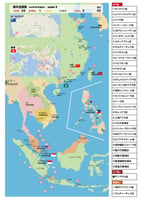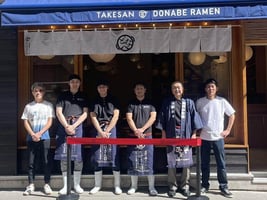最近、日本国内の報道で目にするのが、外食大手の吉野家ホールディングスが「ラーメンで世界を狙う」という記事
濃厚豚骨ラーメン ばり馬の海外出店の軌跡
海外で35店舗展開する、濃厚豚骨ラーメンばり馬の海外出店の軌跡について、弊社のアフリカのマダガスカルからのインターン生Jamesからのインタビュー形式でお伝えします。
・広島のラーメン「ばり馬」について教えて下さい
はい。広島のラーメン「ばり馬」は、濃厚豚骨ラーメンであり、豚骨醤油ラーメンです。
創業者の江口歳春氏が「フランチャイズにしやすいラーメン」を全国行脚して、辿り着いたのが豚骨醤油で、以前は和歌山ラーメンと名乗っていました.「ばり馬」は濃厚豚骨ラーメンが有名です。
それ以外のブランドとしてはとりのすけという鳥のパイタンスープの業態と、つけ麺風雲丸というつけ麺の業態があります。
日本国内で30店舗ほど展開している時に、弊社から声掛けしました。



(海外展開開始前の国内店舗)
・アセンティアHDとはどのような関係でしたか?
元々「ばり馬」を経営するウィズリンクという会社は、私たちがエリア本部で展開しておりました焼肉牛角の加盟店でありました。
焼肉牛角に加盟してフランチャイズを学んでおられました。
私はエリア本部として牛角を全国展開しておりましたので、牛角つながりで関連がありました。
ある日ある企業のご紹介で、広島にこういうラーメン屋がある、面白いラーメン屋なので会ってみて欲しいという相談を受けまして、創業者である江口歳春社長のところにお伺いしました。
実際に展開されている業態を見て牛角を含め様々なフランチャイズ本部に加盟をしてフランチャイズノウハウを学び、ご自身で立ち上げたオリジナルのブランドである「ばり馬」の業態が非常にフランチャイズ向きであることを理解しました。
これであれば海外でも展開できるのではないかというような考えを持ち、ウィズリンクと海外展開についての交渉をスタートしたという感じです。
・海外展開はどちらから提案しましたか?
非常にフランチャイズ向きのパッケージが出来上がっていましたので、これであればフランチャイズ方式で海外で展開できるのではないかと思い、私たちの方から海外展開を声かけました。ただ実際に海外展開をされたことがない会社なのでどの国からやったらいいのか、どのような形で進めるのか、直営でやるのかフランチャイズでやるのか、そのあたりのところの交渉に時間がかかりまして、実際にはシンガポールに法人を設立するまでに1年以上かかった記憶があります。ただ実際には海外への知見がなにもない会社だったので、社長以下役員の心配は相当なものだったと思います。ただ、ラーメンという業態を魅力的に受け入れてくれるのは海外の方であることを説明して、実際にシンガポールに何度も視察に来ていただいて最終的な意思決定をいただきました。
・最初の業務スタートについて教えて下さい
私たちの展開の支援はフランチャイズでの展開が基本なのですが、2011年当時シンガポールやASEAN各国から日本に行くには入国VISAが必要でした。
なかなかVISAを取ってまで日本に店舗の視察に来る方は少ないので、まずシンガポールにアンテナショップとなる直営店を作り、そのシンガポールの店舗を見に来ていただいて近隣諸国にフランチャイズ展開を加速させるという戦略を立てました。
ということで株式会社ウィズリンクの「ばり馬」のシンガポール第1号店は直営での展開となっています。
・法人はどのようにして設立されましたか?
法人の設立につきましては、非常にお世話になっているシンガポールの会計事務所で設立を行いました。日本のウィズリンク社と私たちの共同出資で会社を作っています。
・法人の株主と役員構成を教えて下さい。
資本につきましては日本のウィズリンク社と日本の私たちの共同出資になっています。
役員につきましては日本の江口社長が代表(マネジメントディレクター)になり、シンガポール在住の私がディレクター(取締役)として入りました。ただ立地を決めるとかスピーディーに展開しないといけない業務がありますので、シンガポールにおける全権を頂いて業務展開をさせていただきました。
・1号店の物件はどのようにして決定しましたか?
1号店の物件につきましては契約まで非常に時間をかけた覚えがあります。物件数で言うと多分20から30物件ぐらい見ました。1号店の物件の重要性につきましては今後アジアで「ばり馬」の店舗が加速度的に展開できるかどうかの鍵になると思いましたので非常に注意をして選びました。シンガポールは家賃が高く、特に家賃の高いモールの中の展開は非常に不利だと感じましたので路面での展開を考えておりました。1号店の物件はモールの中にありながら1階で外部に面している物件であり、モール自体そのものは非常に良いモールではなかったのですが、外部の1階から直接入店できるという点で選びました。シンガポールの銀座と言われるオーチャード通りの先1分の場所です。近隣には日本大使館やシンガポールでは珍しい戸建ての豪邸がたくさんあり、またセントレジス等々の高級ホテルも乱立するエリアです。
それらに魅力を感じ、この物件を契約しました。
当時日本の本部は、社長も開発担当者もシンガポールで視察した物件の中で「この物件での出店だけは無いだろう」という物件だったらしいです。。
私自身が取締役で入っておりましたし、最終的な意思決定の権限もいただいておりました。
また私自身シンガポールに在住しこの物件の魅力を十分に感じましたので、この物件に決めて展開することを意思決定しました。

(ばり馬海外1号店 シンガポール タングリン店)
・1号店の人員採用、教育はどのようにしましたか?
日本の本部から日本人3名にシンガポールに来ていただき、立ち上げを行いました。
この3名はその後の海外展開の鍵となるメンバーでした。
国が違うと教育方法が違うのか?と言われますが基本的にはこの3名のメンバーが、シンガポール人である現地の従業員を教育し店舗運営を行いました。なかなか飲食店で働きたいというシンガポールの現地人は少なく、採用や教育に苦労しましたけれども、出店から10年以上経った今でも退職せずにまだ働いてくれているメンバーがいるのは非常に光栄なことです。
・開店当初は売上はどうでしたか?
日本のラーメン屋だからといって最初から人気が出て売り上げが良かったわけではありません。地道なマーケティング活動のもと、近隣のホテルや近隣のオフィスに店舗のチラシを持って訪問したり、日本で行っている地道な営業活動を行ったり、店舗の売り上げがどんどん上がってきました。開店当初は月商5万ドルくらいの売上でしたが、徐々に売上が上がり、5年たって過去最高売上を更新するというような状態を作り上げ、月商12万ドルを超えるような売上を上げるようになりました。
・日本の店舗と大きく味を変えた点はありますか?
これはよく聞かれることなのですが、国が違うと味覚も違うので現地に順応させた方がいいのかと聞かれるのですが、私たちは基本そのまま全て同じレシピで展開をしました。その後に若干微調整をしましたけれども、基本は日本と同じ商品レシピで展開しています。運営する前からあーでもない。こーでもないと調整してると日本と全く違う業態になってしまいますので良くないと思います。
基本は日本で成功したパターンと全く同じものを海外に持って行っています。
.jpg?width=300&height=225&name=CIMG1313%20(2).jpg)
(右から弊社土屋、ばり馬創業者江口氏)
・スープや麺の仕入れについておしえてください
シンガポールは日本のようにコールドチェーンが出来ているので、開店当初はスープに関しては日本のフランチャイズ同様にから冷凍でシンガポールに持って行きました。ただ物流コストが結構高かったので2年ほど経った時に冷凍ではなくレトルトに切り替えました。
麺に関して当初はシンガポールで製麺会社から購入していたのですが、1玉あたりの仕入れが非常に高かったので、店内を4席ほど潰してスペースを作り、製麺機を導入して自店内で製麺するようにいたしました。原価コストも大きく下がり、私たちのスープにあった麺が提供できるようになったので非常に良かったと思っています。
「ばり馬」ではシンガポール以外の各国ASEAN、香港、アジア、オーストラリア、イギリス、全て店舗内で製麺をしています。
レトルト化と店内製麺が世界展開の大きな武器になりました。
(製麺機、写真はばり馬本社のテストキッチンのマシン)
・シンガポールの出店後それ以外の国への展開はどのようにして行いましたか?
シンガポールに出店してからの海外展開につきましては、基本シンガポール法人で全てを行いました。
私が中心となってアジアやアジア中の企業をシンガポールに連れてきて視察ツアーを行い、店舗を見て食事をしていただいて自分の国でこの「ばり馬」という店舗をフランチャイズ加盟して展開するという意思決定を取っていきました。
シンガポールの次に出店した国はマレーシアです。ほぼ同時期にインドネシア、そして中国、香港、台湾、フィリピンと広がっていきました。
マレーシア、インドネシアが初めてのフランチャイズ店舗です。
両店舗とも日本から江口社長もお越しいただき、私も参加して感動的な開店セレモニーとなりました。日本にしか店舗がなかった企業が海外に出店できたことは非常に感慨深いものでした。今ではマレーシアで4店舗、インドネシアで10店舗を展開するまでになり、オーストラリアやスコットランドにも展開しています。
2014年〜2019年のコロナ前までに、たった5年間で35店舗もの海外展開を行いました。シンガポール法人は、英語、中国語で会話が可能な社員が多く、フランチャイズの研修店舗としても活用し、今でも海外展開での中心的な存在となっています。
・出店している国をすべて教えて下さい
シンガポール、マレーシア、インドネシア、フィリピン、オーストラリア、香港、台湾、中国、そしてイギリスです。
・海外でのFC展開で苦労する点はありますか?
海外においては日本のように頻繁にスーパーバイジング活動に行けるわけではないので、味の安定化が多店舗水平展開において非常に重要となります。
これは簡易なオペレーションであれば容易ですのでフランチャイズ向けの業態かどうかという試金石になると思います。また海外の会社は商慣習も違うので加盟金の入金やロイヤルティの入金についても気をつけるところがたくさんあります。過去に28カ国ほど経験してきているので弊社にもノウハウが溜まってきたように思います。
・今は「ばり馬」を展開するウィズリンクは吉野家グループとなっていますがその経緯は?
コロナ前に創業者の年齢の問題もあり江口社長が「ばり馬」を展開するウィズリンクという会社を売却したいという話があり、吉野家グループにその全株を買い取っていただきました。吉野家グループも海外展開するにはラーメン事業が必要であると考えていたようで、またたった5年で海外35店舗に急速にひろがった「ばり馬」事業に非常に魅力を感じたようです。
・今後の展開についておしえてください。
現在は吉野家グループとなっており、既存の加盟店のフォローや新規のフランチャイズ加盟店の発掘活動を行っています。
最近の吉野家ホールディングスのリリースにも出ておりましたが、吉野家グループとして海外展開はラーメン事業を中心に展開したいと考えているようですので、ばり馬ブランドの存在価値は非常に高いと考えており、今後も引き続きまだ展開してないヨーロッパの国を中心にばり馬ブランドを広げていきたいと思っています。
(続く)
聞き手
アセンティア・ホールディングス インターン生 James Rakotomalala(マダガスカル)
話し手
アセンティア・ホールディングス 代表 土屋 晃
The Overseas Expansion Journey of Bariuma's Rich Pork Bone Ramen
We present the overseas expansion journey of Bariuma, a rich pork bone ramen chain with 35 international locations, through an interview format with James, our intern from Madagascar in Africa.
・Please tell us about Hiroshima's “Bariuma” ramen.
Yes. Hiroshima's “Bariuma” ramen is a rich pork bone ramen, specifically a pork bone soy sauce ramen.
Founder Toshiharu Eguchi traveled nationwide seeking a “ramen style suitable for franchising,” arriving at tonkotsu shoyu. It was previously known as Wakayama Ramen. “Bariuma” is famous for its rich tonkotsu ramen.
Other brands include Torinosuke, specializing in chicken paitan soup, and Tsukemen Fūunmaru, specializing in tsukemen.
We approached them when they had about 30 stores operating within Japan.
・What was the relationship with Assentia HD?
Originally, Withlink, the company operating “Bariuma,” was a franchisee of Yakiniku Gyu-kaku, which we were developing as an area headquarters.
They joined the Yakiniku Gyu-kaku franchise and learned about franchising.
As the regional headquarters expanding Gyu-kaku nationwide, we had a connection through Gyu-kaku.
One day, through an introduction from another company, we were approached with the request to meet the founder, President Toshiharu Eguchi, because there was this interesting ramen shop in Hiroshima.
After seeing the actual business model in operation, I understood that “Bariuma”—an original brand he had launched himself after joining various franchise headquarters, including Gyu-kaku, to learn franchise know-how—was highly suited for franchising.
This led me to think it could potentially expand overseas, and that's how negotiations with With-link about global expansion began.
・Who proposed the global expansion?
The franchise package was exceptionally well-developed, so we thought it could be expanded overseas using the franchise model. We were the ones who approached them about going global. However, since they had no prior experience with overseas expansion, negotiations took time on key points: which country to start with, the approach to take, whether to operate directly or via franchising. I recall it took over a year just to establish the legal entity in Singapore. But since the company had zero overseas experience, I imagine the president and executives were extremely concerned. We explained that overseas markets are particularly receptive to the appeal of ramen. After they visited Singapore multiple times for inspections, they finally made the decision.
・Tell us about the initial business launch.
Our expansion support is primarily franchise-based. However, back in 2011, people from Singapore and ASEAN countries needed entry visas to visit Japan.
Few people would go to the trouble of obtaining a visa just to inspect a store in Japan. Therefore, we devised a strategy: first establish a company-owned flagship store in Singapore to serve as an antenna shop. We invited them to visit this Singapore store, aiming to accelerate franchise expansion into neighboring countries.
Consequently, the first “Bariuma” store in Singapore, operated by Withlink Co., Ltd., is a company-owned location.
・How was the corporation established?
The corporation was established through a Singaporean accounting firm that has been extremely helpful to us. The company was formed through joint investment between Japan's With-link Corporation and our group.
・Please tell us about the shareholders and directors of the corporation.
The capital is jointly invested by Japan's Withlink Corporation and our group in Japan.
Regarding officers, President Eguchi from Japan serves as the Representative (Management Director), and I, residing in Singapore, joined as a Director (Board Member). However, since there are tasks requiring swift action, such as deciding locations, I was granted full authority in Singapore to manage operations.
・How was the property for the first store decided?
I recall it took a considerable amount of time to finalize the contract for the first store property. In terms of the number of properties viewed, we probably looked at around 20 to 30. We chose the location for the first store with great care, as we believed its importance would be key to whether “Bariuma” stores could expand rapidly across Asia in the future. Rent in Singapore is high, and we felt opening inside a mall with particularly high rents would be very disadvantageous, so we were looking for a street-level location. The location for the first store was inside a mall but on the first floor facing the outside. While the mall itself wasn't a particularly good one, we chose it because customers could enter directly from the outside on the first floor. It's located just a minute's walk from Orchard Road, often called Singapore's Ginza. The neighborhood features the Japanese Embassy, numerous detached mansions (rare in Singapore), and a cluster of luxury hotels like the St. Regis.
Attracted by these factors, we signed the lease for this property.
At the time, the Japanese headquarters—including the president and development staff-apparently viewed this property among those inspected in Singapore as “the one we definitely wouldn't open a store in.”
I was personally involved as a director and held the final decision-making authority.
Furthermore, as I was residing in Singapore myself and fully appreciated the property's appeal, I made the decision to proceed with this location.
・How did you handle staffing and training for the first store?
We had three Japanese staff members come from the Japanese headquarters to Singapore to handle the launch.
These three individuals became key members for subsequent overseas expansion.
People often ask if training methods differ by country, but fundamentally, these three members trained the local Singaporean staff and managed the store operations. Finding Singaporeans eager to work in the food service industry was quite challenging, making recruitment and training difficult. However, it's truly an honor that some of those members are still working with us over 10 years after opening, without having left.
・How were sales initially after opening?
Just because it was a Japanese ramen shop didn't mean it was popular and profitable from the start. Through steady marketing efforts-like visiting nearby hotels and offices with flyers, and conducting the same diligent sales activities we do in Japan-the store's sales gradually increased. Monthly sales were around $50,000 when we opened, but they steadily grew. After five years, we achieved record-breaking sales, surpassing $120,000 per month.
・Did you significantly alter the taste compared to the Japanese stores?
This is a common question. People ask if we should adapt the taste locally since palates differ by country. However, we fundamentally expanded using the exact same recipes. We made minor adjustments later, but the core product recipes are identical to Japan. We believe constantly tweaking before opening-thinking “this isn't right, that isn't right”-risks creating a completely different business model from Japan, which is undesirable.
Fundamentally, we bring the exact same successful model from Japan overseas.
・Please tell us about sourcing soup and noodles.
Singapore has a cold chain infrastructure like Japan, so initially, we shipped frozen soup to Singapore just like the Japanese franchise. However, logistics costs were quite high, so after about two years, we switched from frozen to retort pouches.
Regarding noodles, we initially purchased them from a local Singaporean manufacturer. However, the cost per bundle was extremely high. So, we sacrificed about four seats inside the restaurant to create space, installed a noodle-making machine, and started producing noodles in-house. This significantly reduced our cost of goods and allowed us to serve noodles perfectly matched to our soup, which we consider a major success.
At “Bariuma,” we make noodles in-house at all locations: not just Singapore, but across ASEAN countries, Hong Kong, Asia, Australia, and the UK.
Switching to retort pouches and in-house noodle production became major weapons for our global expansion.
・After opening in Singapore, how did you expand into other countries?
Regarding overseas expansion after opening in Singapore, the Singapore subsidiary handled everything fundamentally.
I took the lead in bringing companies from across Asia to Singapore for inspection tours. They visited our stores, dined with us, and made the decision to franchise and expand this “Bariuma” concept in their own countries.
The country we opened in next after Singapore was Malaysia. Around the same time, we expanded into Indonesia, then China, Hong Kong, Taiwan, and the Philippines.
Malaysia and Indonesia were our first franchise locations.
President Eguchi traveled from Japan for both openings, and I participated as well, making for truly moving grand opening ceremonies. It was deeply moving for a company with only Japanese locations to finally expand overseas. Today, we operate 4 stores in Malaysia, 10 in Indonesia, and have also expanded into Australia and Scotland.
From 2014 to 2019, before the pandemic, we expanded overseas to 35 stores in just five years. Our Singapore subsidiary, with many employees fluent in English and Chinese, serves as a training store for franchisees and remains central to our international expansion.
・Please list all countries where you have stores.
Singapore, Malaysia, Indonesia, Philippines, Australia, Hong Kong, Taiwan, China, and the UK.
・Are there any challenges in overseas franchise operations?
Overseas, we cannot conduct supervisory visits as frequently as in Japan, making taste consistency crucial for scaling across multiple stores.
This is manageable with simplified operations, making it a litmus test for franchise suitability. Additionally, overseas companies have different business practices, so there are many points to watch regarding franchise fee and royalty payments. Having experienced around 28 countries, we believe we've accumulated considerable know-how.
・With-link, which currently operates “Bariuma,” is now part of the Yoshinoya Group. What was the background?
Before COVID, due to the founder's age, President Eguchi expressed a desire to sell Withlink, the company operating “Bariuma.” The Yoshinoya Group acquired all shares. Yoshinoya Group apparently saw the need for a ramen business for its overseas expansion and was highly attracted to the “Bariuma” business, which had rapidly expanded to 35 overseas stores in just five years.
・Please tell us about future developments.
Currently under the Yoshinoya Group, we are focusing on supporting existing franchisees and recruiting new franchise partners.
As mentioned in a recent Yoshinoya Holdings release, the group intends to center its overseas expansion around the ramen business. We believe the Bariuma brand holds significant value and plan to continue expanding it, primarily targeting European countries where it currently has no presence.
(Continued)
Interviewer
Assentia Holdings Intern
James Rakotomalala (Madagascar)
Speaker
Assentia Holdings Representative
Akira Tsuchiya




